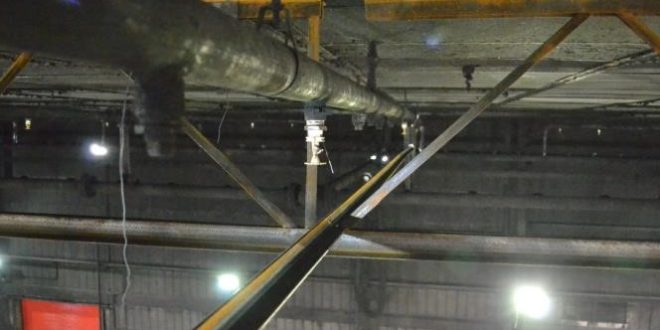The Existing Criteria is Likely Too Conservative
In a continuing and extensive effort to develop reliable and effective tools and guidelines for the unique installation of early suppression fast response (ESFR) sprinklers relative to obstructions, the National Fire Protection Association (NFPA) through its Research Foundation has completed three phases of the project entitled “ESFR Sprinklers and Obstructions.” The contractor for this project has been proficiently led by Garner A. Palenske P.E., and William N. Fletcher, P.E. of Jensen Hughes. This effort is to better define for the end users the guidelines or parameters necessary to minimize obstructions to the effective use of ESFR sprinklers for storage protection. In other words, the intention is to refine the current guidelines, published in standards, with well-developed, quantifiable criteria.
Eight full-scale and 40 actual delivered density (ADD) tests have been completed in the three phases that wrapped up in December of 2016, utilizing K-17 ESFR sprinklers. K-17 ESFR sprinklers were chosen over K-14 ESFRs when the 2013 edition of NFPA 13, Standard for Installation of Sprinkler Systems, removed protection criteria for the K-14s under specific circumstances. The tests were all of Group A, cartoned, unexpanded plastics, stored 30-ft high, in double-row racks under a 40-ft-high ceiling at Underwriters Laboratories, with 4-ft aisles, sprinkler spacing of 10 ft by 10 ft, and sprinklers operating at 52 psi.
For reference, one of the test arrangements is shown in Figure 1. This figure indicates the bar joist sizes utilized in the testing as well as one example of the offsets and locations of the sprinklers relative to the joists and the joist members from Phase 1 of the project. (See Figure 1.)
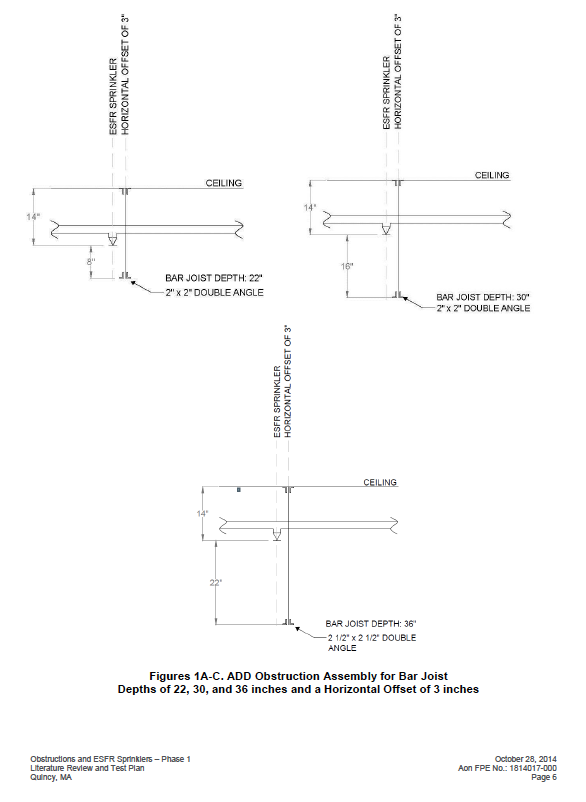
Actual delivered density (ADD) testing of the configurations above provided the following results:
“… 22, 30, or 36-inch deep trusses located directly under the sprinkler would be challenging with discharge pressures of 50 or 75 psi. The 22-inch deep truss offset 3 inches would be challenging for a sprinkler with discharge pressures of 50 and 75 psi. A 30-inch deep joist offset 3 inches would not be challenging for a sprinkler with a discharge pressure of 75 psi. Lastly, a 36-inch deep joist offset 3 inches would not be challenging for a sprinkler with either discharge pressure. In general, the deeper the joist depth, the less the effect on the ADD, since the bottom chord of the joist was farther away from the sprinkler…” 2
Bridging members were added to the testing with both full-scale and ADD tests performed. Figure 2 shows the basic configuration of the bar joists and the bridging members. (See Figure 2 on page 12.)
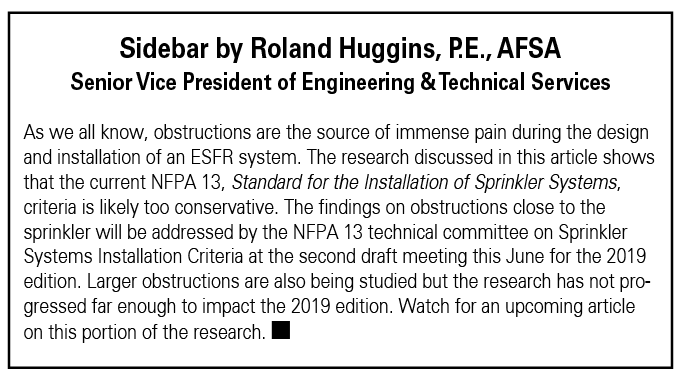
The Phase 2 testing produced results that narrowed the parameters of acceptable locations for obstructions relative to the K-17 ESFR and water distribution. It also indicated clearly that a K-17 ESFR sprinkler located directly above a bridging member of 11/2-in. by 11/2-in. with a vertical separation of 6 in. produced unacceptable results. (See Figure 3 for the test configuration.) During this test the first sprinkler operated at one minute and one second (1:01) with two more sprinklers operating at 2:42 and 3:03, respectively. Twenty additional sprinklers operated between 3:33 and 6:42. (See Figure 3.)
Phase 3 ADD tests were performed on round and flat obstructions that were from 3 to 12 in. in width to compare those ADD results to the ADD results from an unobstructed sprinkler. From the Executive Summary:
“This analysis showed that for obstructions located directly below the sprinkler, the ADD increases as the vertical distance between the sprinkler and the obstruction increases. For obstructions horizontally offset from the sprinkler, the inverse is true; the ADD decreases as the vertical distance between the sprinkler and the obstruction increases.”5
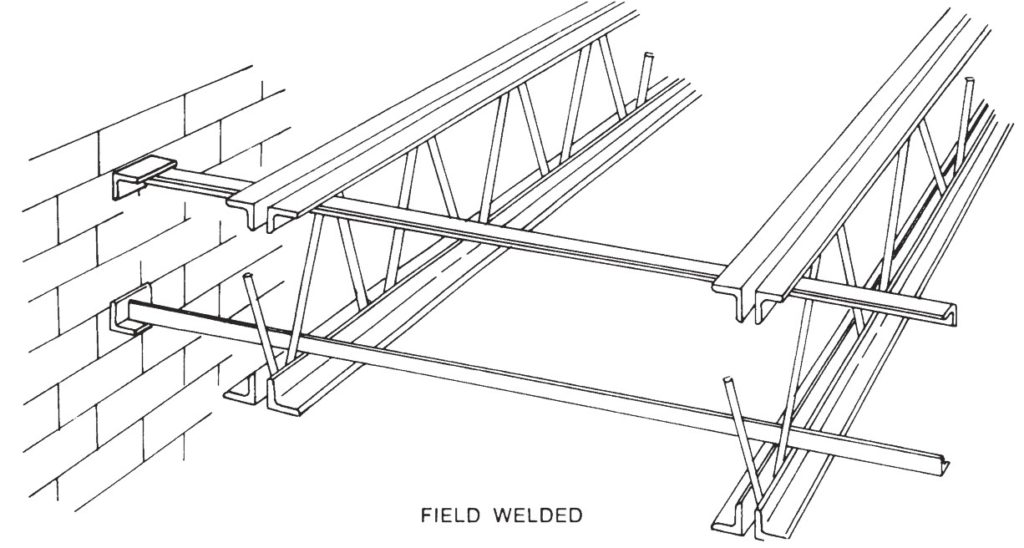
To designers and installers, this means that a 3-in. wide obstruction located directly below, vertically 8 ft 16-in., from a K-17 ESFR sprinkler, “…is a significant obstruction”6 to the spray pattern and sprinkler discharge. The 6-in. wide obstruction located directly below, vertically 8 ft 30 in., from a K-17 ESFR sprinkler, “…is a significant obstruction.”7 Note that when distances are referenced as below the sprinkler it is from the deflector of the sprinkler to the top of the obstruction. Figure 4 below is for reference only, because it shows the test setup but with the 12-in. wide flat obstruction offset, not directly below the sprinkler. (See Figure 4.)
Several of the full-scale tests, combined with ADD results, ended up yielding results that show at least two things. One, there are many variables that make placement of sprinklers, fire location, sprinkler design (K-factor), type, and location of obstruction all factors in determining success or failure; and two, the full-scale testing completed is on the verge of determining realistic parameters that significantly improve the current guidelines.
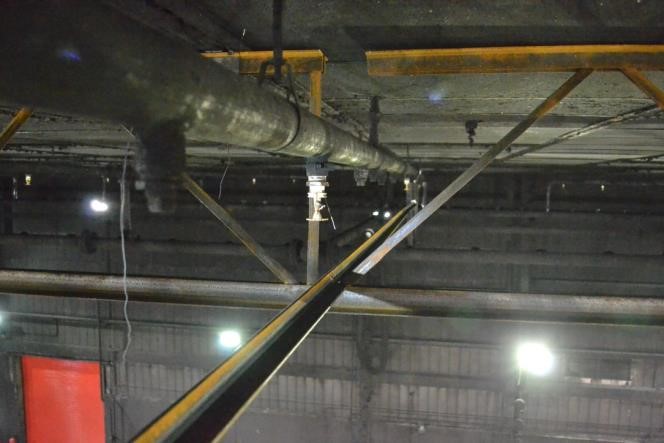
Two of the three full-scale tests completed in Phase 3 were with a 6-in. obstruction in one test and a 12-in. obstruction in the other test. The obstruction was located 20 in. below the sprinkler deflector in both of these tests. The 6-in. wide obstruction allowed one sprinkler activating to successfully suppress the fire. The 12-in. wide obstruction required 10 sprinklers activating to suppress the fire. Figure 5 is the test arrangement that opened 10 sprinklers during the full-scale testing. (See Figure 5 on page 14.)
An excerpt is provided below from the current design guidelines of NFPA 13, 2016 edition, which states in part:
“8.12.5.3.2 Bottom Chords of Bar Joists or Open Trusses. ESFR sprinklers shall be positioned a minimum of 1 ft. (300 mm) horizontally from the nearest edge to any bottom chord of a bar joist or open truss.
“8.12.5.2* Isolated Obstructions Below Elevation of Sprinklers. Sprinklers shall be arranged with respect to obstructions in accordance with one of the following:
“(4) Additional sprinklers shall not be required where the obstruction is 2 in. (50 mm) or less in width and is located a minimum of 2 ft. (600 mm) below the elevation of the sprinkler deflector or is positioned a minimum of 1 ft. (300 mm) horizontally from the sprinkler.
“8.12.5.3.1 General Continuous Obstructions. Sprinklers shall be arranged with respect to obstructions in accordance with one of the following:
“(2) Additional sprinklers shall not be required where the obstruction is 2 in. (50 mm) or less in width and is located a minimum of 2 ft. (600 mm) below the elevation of the sprinkler deflector or is positioned a minimum of 1 ft. (300 mm) horizontally from the sprinkler.
“(3) Additional sprinklers shall not be required where the obstruction is 1 ft. (300 mm) or less in width and located a minimum of 1 ft. (300 mm) horizontally from the sprinkler.”
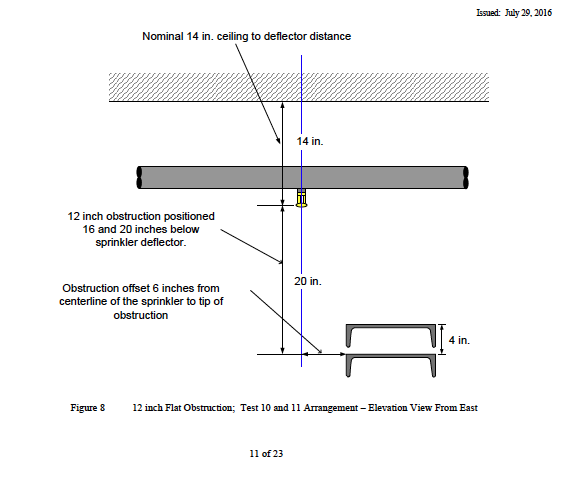
Summarizing the current rules above, the lower chord of the bar joist must be located at least 12 in. from the centerline of the sprinkler, and obstructions up to two in. in width must be located at least 24 in. below the deflector. The testing in this project has better defined those parameters with results that will be included in future editions of NFPA 13.
Combining results of Phases 2 and 3 of the project, it has been concluded that:
- A 1.5-in. by 1.5-in. obstruction located 12 in. directly below a K-17 ESFR sprinkler does not adversely affect the water distribution.
- A K-17 ESFR sprinkler offset horizontally 6-in. from bar joists that are 26 to 36-in. deep with a 1.5-in. x 1.5-in. bridging member 12 in. directly below the sprinkler “will not significantly decrease the performance of the ESFR sprinkler.”8
- A 6-in. wide flat obstruction located 6-in. offset horizontally and 20-in. below the sprinkler produced “acceptable results.”9
These projects, and their results, are defining the obstruction parameters and providing invaluable data that can and will be used in the future to understand obstructions and their effect on the performance of ESFR sprinklers. The Research Foundation is optimistic that additional testing can be funded that will provide more information on the twelve inch wide obstructions, data for smaller vertical clearances, and predictability of sprinkler skipping.
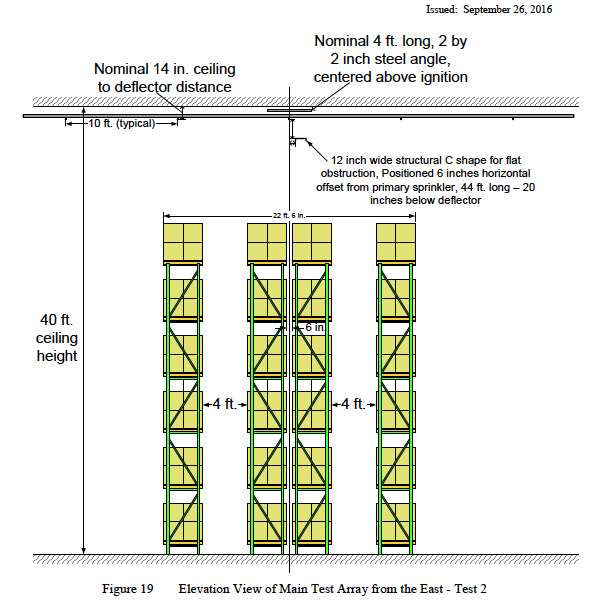
 ABOUT THE AUTHOR: Scott A. Futrell, P.E., F.S.F.P.E., C.F.P.S., S.E.T., C.F.E.I., is a fire protection consultant with Futrell Fire Consult & Design, Inc., in Osseo, Minnesota and has over 40 years’ experience designing, specifying, and investigating fire protection systems. He is a Fellow in the Society of Fire Protection Engineers and serves on the technical panel providing input to the Fire Protection Research Foundation on this project. Futrell can be reached by email at scottf@ffcdi.com or visit ffcdi.com.
ABOUT THE AUTHOR: Scott A. Futrell, P.E., F.S.F.P.E., C.F.P.S., S.E.T., C.F.E.I., is a fire protection consultant with Futrell Fire Consult & Design, Inc., in Osseo, Minnesota and has over 40 years’ experience designing, specifying, and investigating fire protection systems. He is a Fellow in the Society of Fire Protection Engineers and serves on the technical panel providing input to the Fire Protection Research Foundation on this project. Futrell can be reached by email at scottf@ffcdi.com or visit ffcdi.com.
REFERENCES:
1. Palenske and Fletcher. “Obstructions and ESFR Sprinklers – Phase
1”Fire Protection Research Foundation Report, October
2014, Figure 1A-C, page 6.
2. Palenske and Fletcher. “Obstructions and ESFR Sprinklers – Phase
1” Fire Protection Research Foundation Report, October
2014, page 5.
3. Palenske and Fletcher. “Obstructions and ESFR Sprinklers – Phase
2” Fire Protection Research Foundation Report, September
2015, Figure 7, page 13.
4. Palenske and Fletcher. “Obstructions and ESFR Sprinklers – Phase
2” Fire Protection Research Foundation Report, September
2015, Figure 32, page 40.
5. National Fire Protection Association, Research Foundation, ESFR
Sprinklers and Obstructions – Phase 3, Executive Summary,
December 22, 2016, 1 Batterymarch Park, Quincy, MD.
6. National Fire Protection Association, Research Foundation, Obstru-
tions and ESFR Sprinklers – Final Report, December 2016, 1,
Batterymarch Park, Quincy, MD, page 5.
7. Ibid.
8. National Fire Protection Association, Research Foundation, ESFR
Sprinklers and Obstructions – Phase 3, Executive Summary,
December 22, 2016, 1 Batterymarch Park, Quincy, MD. Page 27.
9. National Fire Protection Association, Research Foundation, ESFR
Sprinklers and Obstructions – Phase 3, Executive Summary,
December 22, 2016, 1 Batterymarch Park, Quincy, MD.
 Sprinkler Age A Publication of the American Fire Sprinkler Association
Sprinkler Age A Publication of the American Fire Sprinkler Association
